#natural history museum of denmark
Text
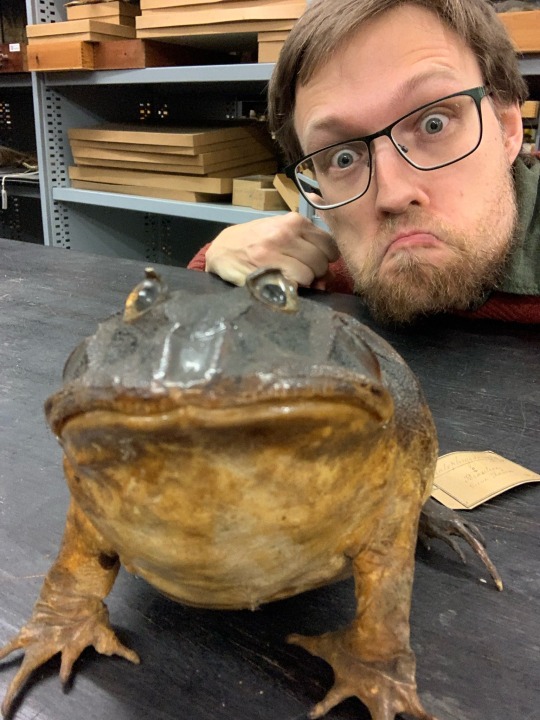
Those stuffed Ceratophrys blues
#this specimen is 182 years old#from Christmas Day in 1842#and we just found out that it isn’t registered in our collection#which I can only attribute to it being so incredibly iconic#like who needs a number to remember this thing??#Ceratophrys#Ceratophrys aurita#Natural History Museum of Denmark#NHMD#my face#that thing on the front of my skull#selfie
844 notes
·
View notes
Text

Pyrophyllite
Natural History Museum of Denmark, Mineral Hall
#pyrophyllite#geology#minerals#mineral hall#mineralology#american minerals#us minerals#america#california#californian minerals#natural history#natural history museum#museum#museums#danish museums#danish museum of natural history#danish natural history museum#natural history museum of denmark#copenhagen#denmark
156 notes
·
View notes
Text
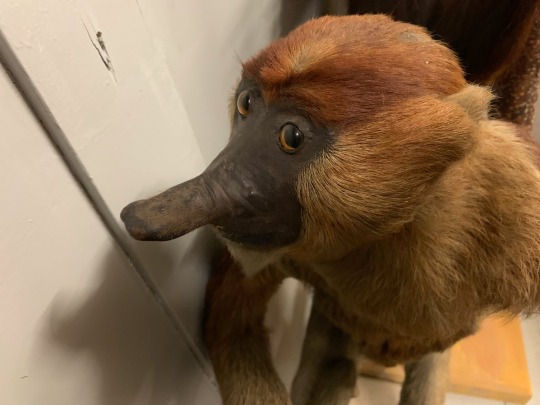

Yet another incorrectly stuffed Proboscis Monkey Taxidermy from the Natural History Museum of Denmark.
1K notes
·
View notes
Text
Was anyone gonna tell me Mark Scherz works 2 minutes from my current lecture halls and that I probably walk past his office several times a week?????
#of all the places in the world#he's in denmark#at the danish museum of natural history#which is on Nørre Campus and directly connected to my university AND my faculty
2 notes
·
View notes
Text

2 notes
·
View notes
Text
Six new beetle species have been discovered in South America by researchers at the University of Copenhagen. Among them is one with a distinctively shaped sexual organ that has led the researchers to name it after global beer powerhouse Carlsberg. According to the researchers, more attention urgently needs to be paid to our planet's millions of unknown species before it's too late.
Penises are more prevalent in some lines of work than others. And for researchers who study biodiversity of insects, penises play a significant role in their daily workload—for good reason.
"Genitalia are the organs in insects that evolve to be different in every species. As such, they are often the best way to identify a species. That's why entomologists like us are always quick to examine insect genitalia when describing a species. The unique shape of each species' genitals ensures that it can only reproduce with the same species," explains biologist Aslak Kappel Hansen of the Natural History Museum of Denmark, whose work entails describing insect species.
By studying beetle specimens that have been hidden in the Natural History Museum of Denmark and other insect collections of the world for decades, Aslak and colleagues José L. Reyes-Hernández, Josh Jenkins Shaw and Alexey Solodovnikov have discovered six new species of the rove beetle genus Loncovilius.
Continue Reading.
184 notes
·
View notes
Text

Peder Severin Krøyer (1851-1909)
"Portrait of Otto Diderich Ottesen" (1873)
Oil on canvas
Located in the Museum of Natural History, Hillerød, Denmark
Otto Diderich Ottesen was a Danish artist known for his still life paintings of flowers.
#paintings#art#artwork#genre painting#male portrait#peder severin krøyer#peder severin kroyer#oil on canvas#fine art#museum#art gallery#danish artist#portrait of a man#flowers#history#clothing#clothes#beard#hat#portrait of the artist#1870s#late 1800s#late 19th century#a queue work art
96 notes
·
View notes
Text
The World’s Smallest Vertebrate Is a Tiny Brazilian Frog, Study Finds
Adult male Brazilian flea toads are just over 7 millimeters long on average, and females measure about 8.15 millimeters

A tiny frog endemic to the state of Bahia on Brazil’s Atlantic coast may have just earned the title of the smallest vertebrate in the world.
The Brazilian flea toad, or Brachycephalus pulex, was first discovered in 2011—and despite its name, it is technically a frog, not a toad. Researchers immediately suspected the creature could break the record for the tiniest frog—and vertebrate—on Earth, but it wasn’t until a new study that scientists systematically measured the lengths of the species’ males and females.
The male frogs, which are smaller, measured 7.10 millimeters long on average, the team reported this month in the journal Zoologica Scripta. An earlier study of the frog Paedophryne amauensis, the previous record holder, found that its males averaged 7.70 millimeters in length.
“It’s absolutely clear,” Mark Scherz, an evolutionary biologist at the Natural History Museum of Denmark who did not contribute to the findings, tells New Scientist’s Jake Buehler. “These really are potentially the smallest extant frogs in the world, which is astonishing.”
Continue reading.
58 notes
·
View notes
Text
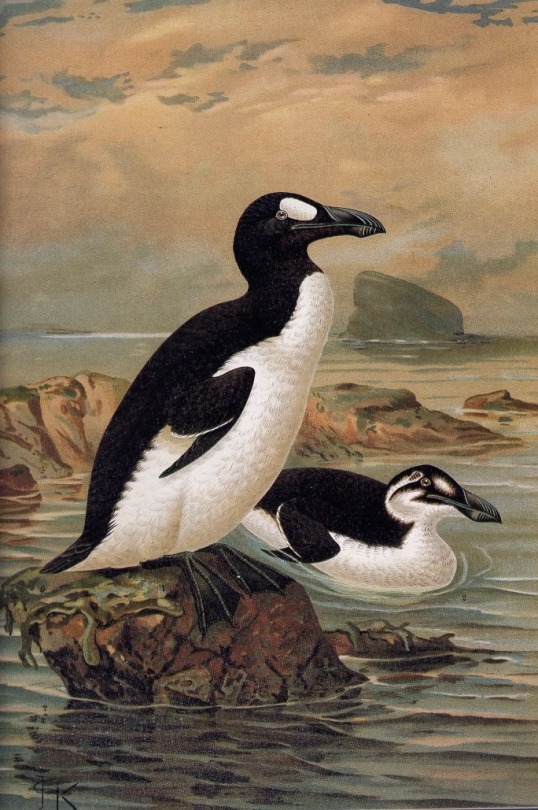



Lady Cust's Great Auk egg
An Egg of the Extinct Great Auk (Pinguinus impennis), Iceland, 1844
Eggs of the Great Auk are regarded as being among the most sought-after of all natural history objects, due to their exceptional rarity. The Victorians thought of them so highly that every surviving egg was listed and its whereabouts carefully recorded. At this time more than 60 had survived and each of these had been collected in the years before 1844, when the bird itself became extinct.Today, almost all of those that still exist are in museums from which they will never be released with only four remaining in private hands.
The Great Auk was a flightless, aquatic bird measuring approximately 2½ feet tall and weighing on average 11 pounds. With a black body and white underbelly, its appearance fell somewhere between a puffin and a penguin. When hunting, the Great Auk employed a hooked beak and powerful swimming stroke to stalk fish and crustaceans. Native to the cold waters of the North Atlantic, their nesting areas ranged from the coasts of Newfoundland, Maine, Massachusetts, and even South Carolina and Florida, to Iceland, the Faroe Islands, the eastern coast of Greenland, and the islands off the coast of Scotland, namely the Orkneys and St Kilda; during the winter months they were known to go as far west as Norway and Denmark, and skeletal remains have been found as far south as Gibraltar.
Great Auk pairs mated for life, laying but one egg per breeding season on small islands and rocky coastlines. The longitudinal, pear-shaped eggs were perfectly adapted to roll in tight circles, greatly reducing the chance of being lost off a cliff edge. Parents would take turns incubating the egg, all while benefitting from the protection of dense social colonies and few natural predators.
Historical records indicate that the Great Auk showed no innate fear of humans, and this—coupled with their slow and awkward movements on land—greatly increased their vulnerability to extinction as Europeans began to massively exploit the species for food, for their downy feathers, and horrifyingly, for kindling in fires, as their very oily feathers were highly flammable.
On June 3, 1844, the last known breeding pair of Great Auks were killed off the coast of Iceland, on Eldey Island, after being captured by fisherman, making this incredibly rare specimen a poignant reminder of humanity's responsibility to conservation and environmental stewardship.
Because of their tragic history, Great Auk eggs are exceedingly rare, and even more so in private hands. Thanks to the efforts of early passionate ornithologists, in particular Symington Grieve, Edward Bidwell, Paule Marie Louise & John Whitaker Tomkinson, Ch. F. Dubois, and Leon Olpho-Galliard, surviving specimens of skins and eggs, including the present example, are well-documented in the literature.
The first record of Lady Cust’s Egg is that it was bought in Paris during the first half of the nineteenth century by the celebrated naturalist William Yarrell who presented it to Lady Cust. No-one knows quite why he did this, but she kept it for many years. At her death it passed into the collection of another well-known ornithologist, George Dawson Rowley, and it has passed through the collections of several other illustrious naturalists (including Captain Vivian Hewitt) in the years since his time.
The egg is listed and its story told in Symington Grieve’s celebrated monograph The Great Auk (1888), P. and J., Tomkinson’s Eggs of the Great Auk (1966) and Errol Fuller’s comprehensive book The Great Auk (1999).
Top right photo: LADY CUST’S EGG ILLUSTRATED IN TOMKINSON'S CELEBRATED TREATISE EGGS OF THE GREAT AUK (PUBLISHED IN 1966, BUT THE PHOTOS TAKEN CIRCA 1900).
Sotheby’s
174 notes
·
View notes
Text
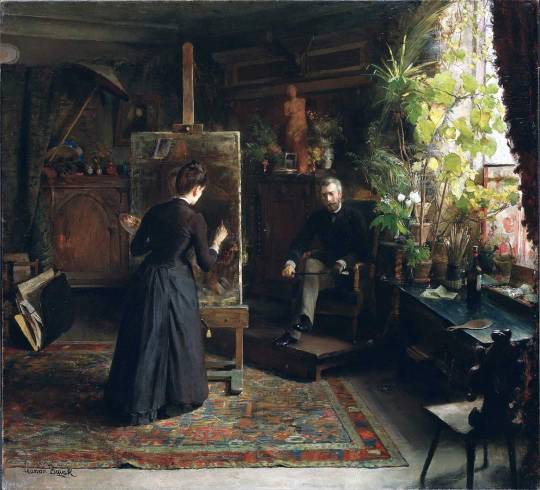
Jeanna Bauck (Swedish painter) 1840 - 1926
Den danska Konstnärinnan Bertha Wegmann målande ett Porträtt (The Danish Artist Bertha Wegmann Painting a Portrait), 1889
oil on canvas
Jeanna Bauck has depicted her close friend and colleague Bertha Wegmann while working on a portrait of Peter Dethlefsen, a Danish physician. It is an epoch-making painting capturing a woman artist in her professional role during concentrated work in her own studio. Bauck and Wegmann met in Munich in the 1870s. They lived for many years in an intimate private and professional partnership and painted several friendship images of each other.
* * *
Catalogue Note National Museum
This is an epoch-making image from 1889, when women artists and writers had a major influence on the cultural life of the period. They managed to change both the view, of the role of the artist and that of middle-class family life.
Here Jeanna Bauck has chosen to depict a female artist in the middle of the creative process. She portrays Bertha Wegmann fully absorbed in her work at the easel, in their shared studio and home in Munich. Wegmann, who was to become one of Denmark’s foremost portraitists, later painted Jeanna Bauck in their studio in Paris in 1881. In that painting, she managed to combine the free, independent woman of the time, “The New Woman”, with the refinement of middle-class femininity. Around this period, artists painted countless portraits of their friends and colleagues, but it was only the women who portrayed each other in their professional role. The will to create art is acknowledged as being paternal within a patriarchy, and as long as patriarchal societies’ are considered “natural”, it is “unnatural” and “unfeminine” for a woman to be an artist.
In the 19th century a hierarchical division between public and private space was established and which still exists today. In modernist art history, the home is therefore described as a timeless zone; the so-called women’s sphere is regarded as a static stage in relation to the narrative of modernity taking place in the public space of a dynamic city. At the time, since middle-class women were not able to move freely in the streets, women artists had to depict modernity from differing social spaces than their male colleagues. One can therefore in their images see which “spaces” were open for their portrayals. Paintings by Nordic female artists show that they literally did not move beyond the studio: it was both their home and place of work. A social space associated with professional life and thereby with the public realm. In their portraits’, the studio represents at once a space of endless possibilities, but also the absolute limit of their world. They chose not to paint the modern city outside, in contrast to the female artists of the avant-garde, who had to depict modernity from balconies and theatre boxes.
* * *
Jeanna Bauck was a Swedish portrait painter and landscape artist. She moved to Germany in 1863, studying in Dresden and Düsseldorf before settling in Munich. In the 1870s, Bauck made several study and sketching tours to the Tyrol, Switzerland and Venice. In 1880, she travelled to Paris, together with Danish artist Bertha Wegmann, with whom she shared a studio. Bauck succeeded in entering the Paris Salon that same year. In a series of groundbreaking portraits of one another, specifically in their professional role’s, Bauck and Wegmann managed to change the view of women artists in what was then seen as a traditionally male occupation. Bauck soon returned to Munich and founded a school for female artists. She exhibited in Sweden on several occasions, including at the Royal Academy exhibitions of 1866, 1868 and 1877, and the exhibition of Swedish female artists in 1911.
5 notes
·
View notes
Text
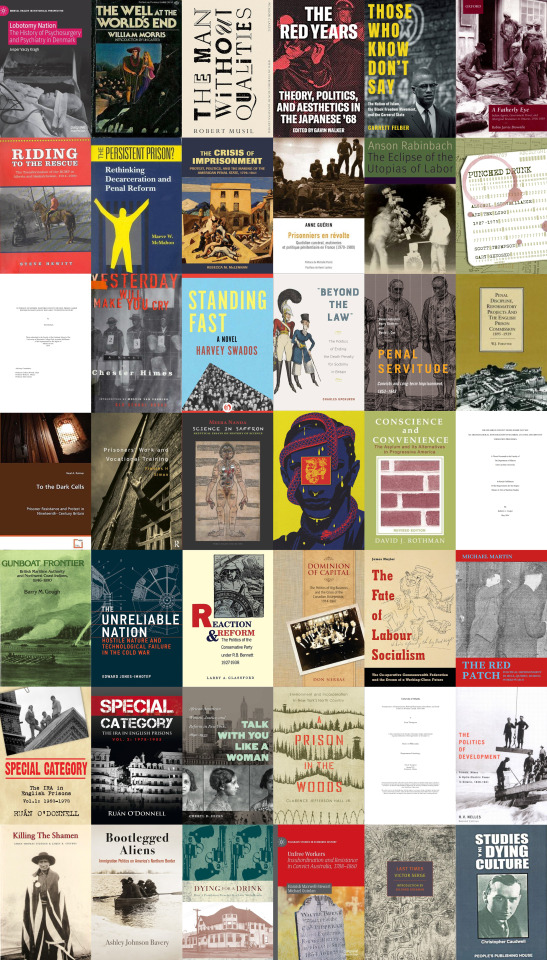
BOOKS I READ IN 2023
Here's what I read in 2023. What has now become an annual tradition of sorts!
An unusual year in reading for me. The first half of the year was very slow, and I mostly finished two long books I've been trying to finish for years by William Morris and Robert Musil. Then the PSAC strike, and more time to read. After that, I made a reading plan and stuck to it, trying to read every day at least a chapter of a book on the list. I also ended up re-reading several books this year - transcribing notes at first, I ended up going over the entire book a second time. I also tried to take extensive notes on every new book. I also snuck a few theses I read onto the list - it feels weird not to include a several hundred page work I went over with a fine-toothed comb. Mostly academic books, germane to my own research and writing, but some strong forays into topics I don't normally think about much. Plus some genuinely good 'amateur' history, too.
Re-reads are marked by a plus sign and my most enjoyable or interesting reads are marked with an asterisk.
First Row:
Jesper Vaczy Kragh, Lobotomy Nation: The History of Psychosurgery and Psychiatry in Denmark (2021)
William Morris, The Well at the World's End (1896, Ballantine edition 1975)
Robert Musil, translated by Sophie Wilkins, The Man Without Qualities (1930, Picador edition 2017)*
Gavin Walker, ed., The Red Years: Theory, Politics, and Aesthetics in the Japanese ’68 (2020)*
Garrett Felber, Those Who Know Don't Say: The Nation of Islam, the Black Freedom Movement, and the Carceral State (2020) *
Robin Jarvis Brownlie, A Fatherly Eye: Indian Agents, Government Power, and Aboriginal Resistance in Ontario, 1918-1939 (2003)
Second Row:
Steve Hewitt, Riding to the Rescue: The Transformation of the RCMP in Alberta and Saskatchewan, 1914-1939 (2006)
Maeve McMahon, The Persistent Prison?: Rethinking Decarceration and Penal Reform (1989)+
Rebecca McLennan, The Crisis of Imprisonment: Protest, Politics, and the Making of the American Penal State, 1776–1941 (2007)+
Anne Guérin, Prisonniers en révolte: Quotidien carcéral, mutineries et politique pénitentiaire en France (2013)+
Anson Rabinbach, The Eclipse of the Utopias of Labor (2018)
Scott Thompson & Gary Genosko, Punched Drunk: Alcohol, Surveillance and the LCBO, 1927-1975 (2009)
Third Row:
Erin Durham, "In Pursuit of Reform, Whether Convict or Free: Prison Labor Reform in Maryland in the early Twentieth Century." (2018 thesis)
Chester Himes, Yesterday Will Make You Cry (1998)*
Harvey Swados, Standing Fast: A Novel (1971, 2013 Open Road edition)
Charles Upchurch, "Beyond the Law": The Politics of Ending the Death Penalty for Sodomy in Britain (2021)
Barry Godfrey, David J. Cox & Helen Johnston, Penal Servitude: Convicts and Long-Term Imprisonment, 1853–1948 (2022)
W.J. Forsythe, Penal Discipline, Reformatory Projects And The English Prison Commission, 1895-1939 (1991)
Fourth Row:
Neal A. Palmer, To the Dark Cells: Prisoner Resistance and Protest in Nineteenth-Century Britain (2008)
Frances H. Simon, Prisoners' Work and Vocational Training (1999)
Meera Nanda, Science In Saffron: Skeptical Essays On History of Science (2016)*
Gene Wolfe, The Book of the New Sun (four volumes, 1980-1983, Folio Society edition 2021)+
David J. Rothman, Conscience and Convenience: The Asylum and Its Alternatives in Progressive America (2002)+
Kathryn Cooper, "The Infamous Convict Museum Ship Success : an Archaeological Investigation of Material Culture and Identity Formation Processes." (2014 thesis)
Fifth row:
Barry M. Gough, Gunboat Frontier: British Maritime Authority and Northwest Coast Indians, 1846-1890 (1984)
Edward Jones-Imhotep, The Unreliable Nation: Hostile Nature and Technological Failure in the Cold War (2017)*
Larry A. Glassford, Reaction and Reform: The Politics of the Conservative Party under R.B. Bennett, 1927-1938 (1992)
Don Nerbas, Dominion of Capital: The Politics of Big Business and the Crisis of the Canadian Bourgeoisie, 1914-1947 (2013)
James Naylor, The Fate of Labour Socialism: The Co-operative Commonwealth Federation and the Dream of a Working-Class Future (2016)
Michael Martin, The Red Patch: Political imprisonment in Hull, Quebec during World War 2 (2007)
Sixth Row:
Ruán O'Donnell, Special Category: The IRA in English Prisons, Vol. 1: 1968-1978 (2012)*
Ruán O'Donnell, Special Category: The IRA in English Prisons, Vol. 2: 1978-1985 (2015)*
Cheryl D. Hicks, Talk with You Like a Woman: African American Women, Justice, and Reform in New York, 1890-1935 (2010)*
Clarence Jefferson Hall, A Prison in the Woods: Environment and Incarceration in New York's North Country (2020)
Scott Thompson, "Consequences of Categorization: National Registration, Surveillance and Social Control in Wartime Canada, 1939-1946." (2013 thesis)
H.V. Nelles, The Politics of Development: Forests, Mines, and Hydro-Electric Power in Ontario, 1849-1941 (2005)+
Seventh row:
Chief Thomas Fiddler & James R. Stevens, Killing the Shamen (1985)
Ashley Johnson Bavery, Bootlegged Aliens: Immigration Politics on America's Northern Border (2020)
Patrick Brode, Dying for a Drink: How a Prohibition Preacher Got Away with Murder (2018)
Hamish Maxwell-Stewart & Michael Quinlan, Unfree Workers: Insubordination and Resistance in Convict Australia, 1788-1860 (2022)*
Victor Serge, translated by Ralph Manheim, Last Times (1946, 2022 NYRB edition)
Christopher Cauldwell, Studies in a Dying Culture (1938)
#books#reading#books 2023#year end list#2023 reading list#canadian history#prison history#academic quote#academic research#academic books#australian history#british history
6 notes
·
View notes
Note
Been meaning to go to the national history museum, what are your fav exhibits I should check out?
Right now we have a visiting exhibit on primates at the Natural History Museum of Denmark, which I think is pretty well done. Definitely worth a visit. We also have some new temporary exhibits on the way. But our exhibit spaces are pretty reduced at present while we work on the development of new galleries and exhibits for the new building, which will hopefully be opening in the next two years!
#museum#natural history museum#Natural History Museum of Denmark#NHMD#Statens Naturhistoriske Museum#answers by Mark#anon#anonymous
48 notes
·
View notes
Text

Silver
Natural History Museum of Denmark, Mineral Hall
#silver#norwegian minerals#norway#geology#minerals#mineralology#mineral hall#kongsberg#museum#museums#danish museums#natural history#natural history museum#danish natural history museum#natural history museum of denmark
110 notes
·
View notes
Text
So interesting story from my local gay bar: we recently entered a collab with a local museum doing an exhibit about a gay late 19th century/early 20th century bussinessman and using that as a jumping off point to discuss the history of queer culture throughout the region.
So naturally, the head of our org asked the curator of the museum like "hey do you wanna check our archive?", and she was like "your archive? I didn't know you had one." (I didn't either)
So the head of the org explains that you know, this gay amateur historian spent much of his life archiving queer culture and history in Denmark, and that after his death the archive was passed on to the bar. And as the head of the org explained to the rest of us "when she (the curator) heard about it, she nearly peed herself with excitement."
And I don't know I think its just a neat reminder that like, queer history exists, its just squirreled away in the backrooms of bars, and private homes
12 notes
·
View notes
Text
Princess of Wales - 2022 Statistics (FULL YEAR)
In 2022, the new Princess of Wales completed (by my count) 168 engagements, around 53 more than the amount of engagements she completed by my count in 2021 and 39 more than 2020. As well as this, she was sighted (or appeared) 16 times and appeared in a whopping 26 official (or unofficial and leaked!) photographs.
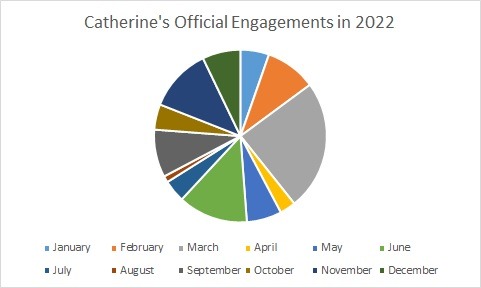
She gained four new patronages throughout the year and finished with 25 patronages. Of her 168 engagements, 67 were related to one of her patronages, averaging at one patronage visit every 0.39 engagements. Her most visited patronage was, of course, the Royal Foundation of the Prince and Princess of Wales (formerly, the Royal Foundation of the Duke and Duchess of Cambridge), with 46 visits. This was followed by the Lawn Tennis Association and the All England Lawn Tennis and Croquet Club (with 3 visits). She performed no engagements on behalf of The Air Cadet Organisation, the Anna Freud National Centre for Children and Families, Evelina London Children’s Hospital (she unofficially visited the hospital during the Platinum Jubilee celebrations), Family Action (she supported them in an article in Good Housekeeping), the Forward Trust, the National Portrait Gallery (her birthday portraits were released in conjunction with the NPG), the Natural History Museum, Place2Be, the Royal Photographic Society, the Scouts, or the Victoria & Albert Museum.

Of her engagements, 64 have been solo and 73 accompanied by her husband, the Prince of Wales. Five were also with either Prince George or Princess Charlotte, five with a range of foreign royals (including the two in Denmark), as well as 20 with either the whole or most of the working British Royal Family (note: some of the events with foreign royals also included a lot of members of the British Royal Family), and one with one other solo royal (the Princess Royal).
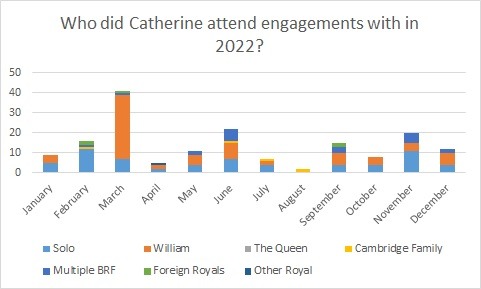
105 of her engagements physically took place in England, with all bar 48 physically occuring in the United Kingdom (with none in the Republic of Ireland). Of the 105 engagements which took place in England, 70 occured in London. Catherine's engagements also took her to 19 other areas of the UK. Only 7 were online or via telephone. Catherine also performed engagements in Wales, Scotland, and Northern Ireland. Catherine also undertook a working trip to Denmark, a tour of the Caribbean (which saw her visit Belize, Jamaica and the Bahamas), and an official visit to Boston in the USA.
During the year, she performed engagements on a variety of themes. 32 of those engagements were predominantly related to her Early Years initiative, while 15 were linked to culture and 13 linked to sports. Due to the return of overseas trips, State Visits, and the death of HM Queen Elizabeth II, 35 engagements were diplomatic in nature. 10 engagements were on the theme of mental health, while she also completed 9 engagements linked to children and young people, 7 linked to the military, 5 linked to Covid-19, 3 linked to the outdoors, and 1 which was specifically linked to the Commonwealth. Catherine also completed 38 engagements which could not otherwise be categorised.
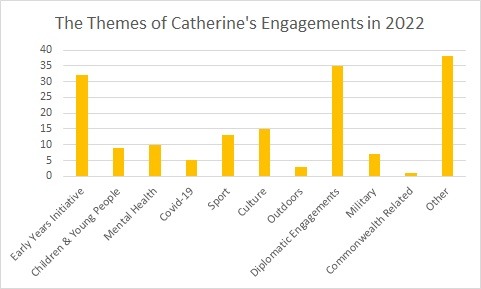
Clotheswise, her most worn designer has been Alexander McQueen, with 25 outfits, followed by 10 outfits from Catherine Walker, while 18 items of clothing were unidentified. Her most carried bag designer was Mulberry (12), followed by Emmy London with 9, and 5 which were unidentifed. Mulberry has been her most carried bag designer in every year apart from 2020. Her most worn shoe designer returned to being Gianvito Rossi (with 37 wears), followed by 11 pairs from Emmy London, and 6 from both Rupert Sanderson and Jimmy Choo. Gianvito Rossi was her most worn shoe designer in 2016, 2017, 2018, 2019, and 2020. Despite Kiki McDonough creeping back into her earring rotation (with 18 wears), Catherine predominantly wore pieces inherited from either Diana (20) or the Queen (19). Aside from them, she also wore Annoushka jewellery 11 times. When it comes to accessories, she continued to wear face masks from Amaia Kids (5 times), although the return of hats meant her top accessories designer was Philip Treacy. She also wore 8 unidentified pieces. According to my (100% wrong) calculations - created from my own criteria (where items are counted each time she wears them), she wore £109,654.98 worth of new clothes this year and £271,423.79 worth of clothes in total.
48 notes
·
View notes
Text

I am very excited to see this extant 1840s men's neckwear in this view, even if it doesn't look like much! The Victoria & Albert Museum simply calls it a "cravat", but it's in the form of a stock that buckles at the back of the neck, with a bow in front and long ends that cover the chest. It's a look I've seen in 1840s portraits and fashion plates. Here it is on a mannequin:


And in an 1843 illustration detail from Joseph Couts' A Practical Guide for the Tailor's Cutting-room, showing a man with Chesterfield overcoat, this style of scarf-like tie, and a tie pin.
The Handbook of English Costume in the 19th Century by C. Willett and Phyllis Cunnington notes, "Tie pins were now extremely fashionable [in the 1840s], worn with neck-clothes that spread over the shirt front, and also with stocks."
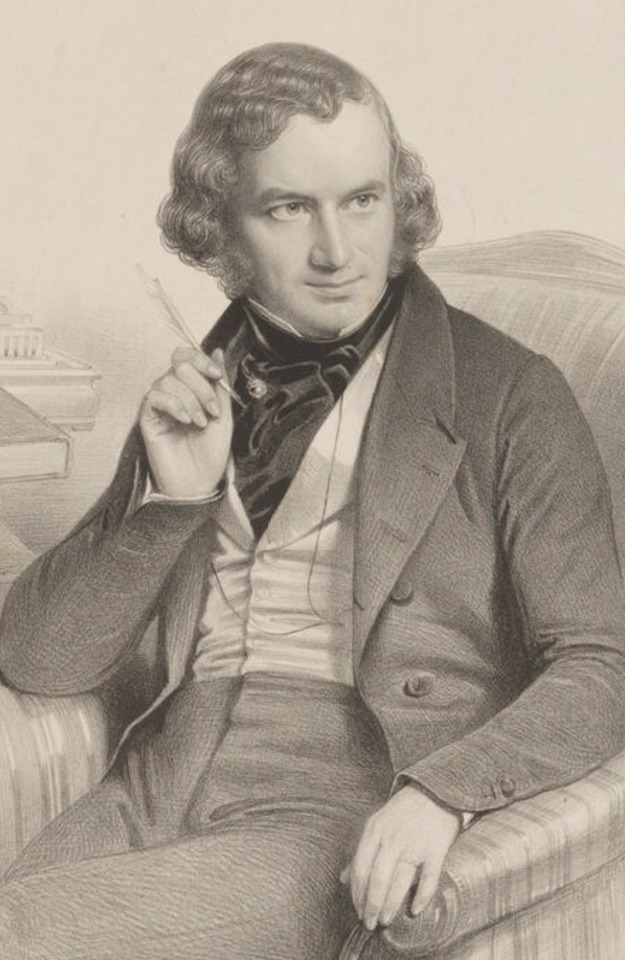
Albert Smith, author of The Natural History of the Gent, in an 1844 portrait (and looking just as bitchy as you would expect). A large tie pin adorns his neckwear.

1843 fashion plate, Met Collection. Two out of the three gentlemen have neckwear that drapes to cover the shirt.
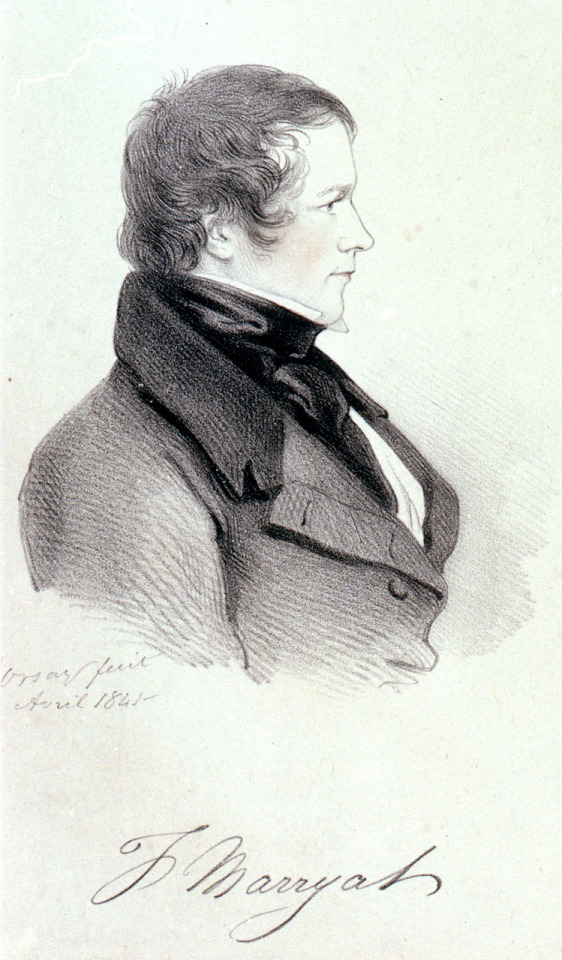
The novelist Captain Frederick Marryat, drawn in 1841 by Alfred d'Orsay, for his 'Drawings of Men About Town' series. The appearance of his neckwear tracks with it being a stock collar with long, draping ends in front.

Carl Wilhelm Lange (National Museum, Denmark), c. 1840s with long ends of his neckwear covering his shirt, with tie pin and other bijouterie.
#1840s#men's fashion#historical men's fashion#fashion history#neckwear#cravat#dress history#victorian#fashion plates#got no. 1 blorbo in here#bijouterie#men's jewellery#fashion#albert smith#frederick marryat
147 notes
·
View notes